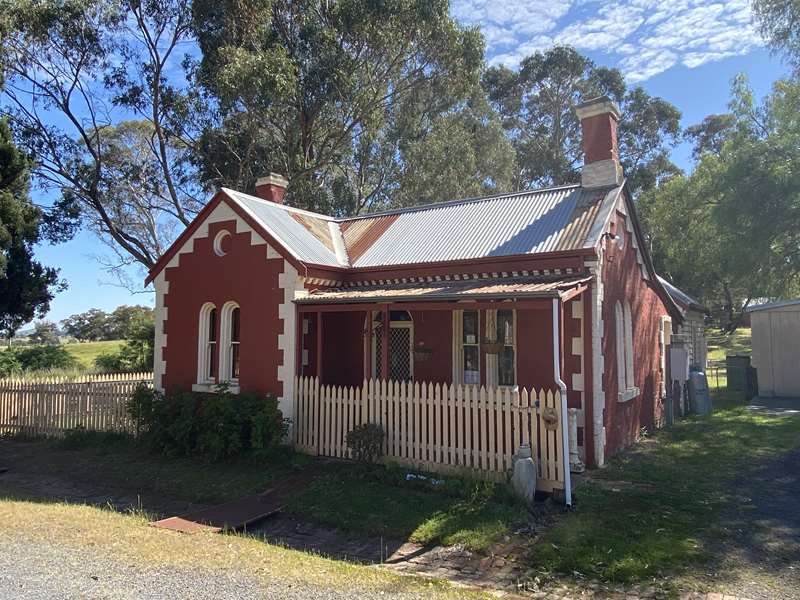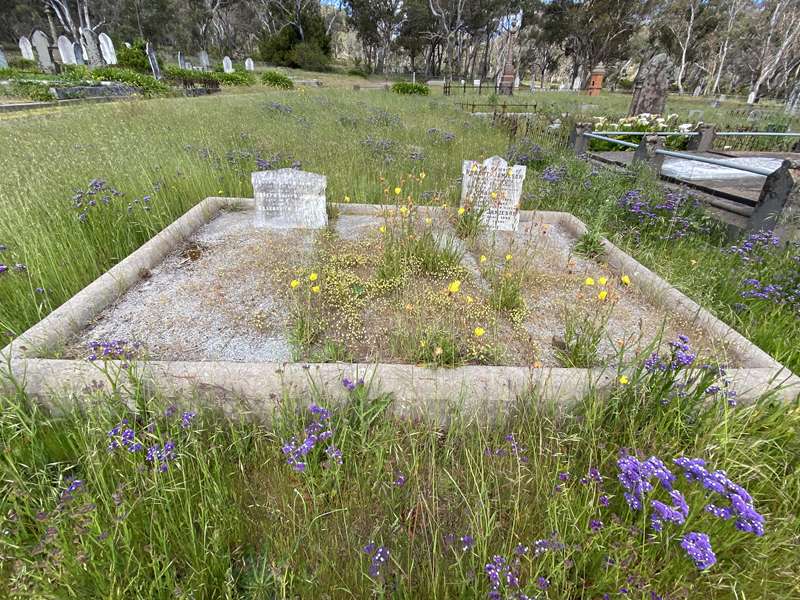Maldon General Cemetery


The Cemetery's main gates were erected in 1890 and remained in their original state until they were re-painted and re-hung in 1990.
As you walk through the entrance to the Cemetery you will see the original caretaker's cottage to the left, built in 1866 and restored in 1977. The rotunda was built soon after the cottage as a shelter for mourners and small gatherings for burials of the 'unknown'. The original rotunda fell victim to a bushfire and was rebuilt in 1977.

Look at the Cemetery map inside the rotunda to locate the areas mentioned in this brochure.
Inside the main gate, turn right on the third path between graves to view on the right the grave of Jane Shearer (nee King), who was the aunt of John King, the sole survivor of the ill-fated expedition by Burke, Wills, Gray and King. John King was rescued in 1861 after being cared for by local aborigines. Jane's grave has a plaque detailing this historical event.
The Pioneer Section of the Cemetery is perhaps the most interesting and significant in the Central Goldfields. The Cemetery's first interments were recorded from 1854. In 1860 three Wardens were appointed and the Cemetery was gazetted. A certificate was awarded to the Cemetery by the Department of Human Services in 2004 to mark 150 years of interments. A lot of the graves hold several generations.
Many miners were buried as 'unknown' or 'unidentified' in paupers' graves in a separate section along the right side boundary fence. Graves of early businessmen line the Cemetery paths. The grave of John Tobin, General Store and Hotel proprietor, lies next to the sign at the front of the Pioneer Section. The graves described below are in Section 5 (refer to the map in the rotunda).
The graves of William and Mary Bowe. The Bowe family was well known for their masonry. (Take the left-hand path around the Pioneer section, then the first path to the left - the graves are on the right.)
The grave of George Ray and his family, with an angel looking out over the section. George Ray used to drive the coach from Dunolly to Castlemaine, long before the train came to Maldon in 1884. (Turn left after the caretaker's cottage inside the gates, then take the first path to the right - the grave is half-way up on the left.)
The Chinese who came to the Maldon Goldfields purchased a separate section towards the back of the Cemetery. The burning tower was used to cook sacrificial meats which were then eaten as part of the funeral ceremony. This oven is a lasting memorial to the Chinese who came in search of gold. On the right-hand side of the Pioneer Section (just along from the sign), there is an unusual grave on the left, standing as a lone stone, with Chinese characters (which are facing away from the path).

The Chinese section holds a few more graves, but most of the headstones here have been destroyed over time by fire and the elements. It is believed that more than 100 Chinese people were buried in this section.
A number of nationalities are buried in the Cemetery, the Irish using crosses for faith. There are various tombstones with special meanings: obelisks; open books or Bibles for the book of life; and ivy sprays for eternity. For many months of the year the Cemetery is covered with cream, mauve and pink 'Four o'clockers' (Mirabilis Jalapa), so called because they open wide on sunny days and close up at 4 o'clock in the afternoon. A yarn is told about them.
During the gold rush that opened up Victoria, a South African clipper docked in Melbourne, whereby the crew took of for the gleam of gold...
Unable to sail without them, the gallant captain set off to bring them back. But like many before him he succumbed to a fever and never recovered.
Back in South Africa, when the news of his death reached her, his widow was immediately struck down with the melancholy thought of him lying alone in foreign soil, with no one around him from his homeland.
So, when the next South African ship berthed in Melbourne, it carried a small parcel of sun-loving bulbs to be scattered on a lonely grave in Maldon. From then on they thrived and spread, eventually covering the whole Cemetery, and the surrounding land, in a rainbow of colours!
There is an impressive gravestone of Samuel Gath, buried in July 1876. His wife Mary Josephine and son S.F. Gath are also buried with him. (Walk up right-hand path of Pioneer Section, the grave is on the left, near the last cypress pine.)
The following information appears in the rotunda about the cemetery.
MALDON CEMETERY - The Cemetery site of 20 acres (8.1 hectares) was officially gazetted in 1866 together with the erection of a Sexton's Lodge. (The first Sexton engaged received 30 shillings per week). The Rotunda was constructed about 1900.
Prior to the formation of a Cemetery Trust, there would have been numerous unrecorded burials in the surrounding area. But it is known that the first recorded burial was on the 9th January 1857, and that Chinese burials took place from 1862. Further internments in 1864 were made of bodies removed from ground near the site of the Methodist Church, which was required for roadworks.
In 1953, which marked the first hundred years of settlement in the Tarrengower/Maldon area, there were more than 5,100 burials including 121 Chinese (mostly unidentified). In the next forty years to 1993, a further 860 burials took place bringing the total to almost 6,000. (This lower rate of burials in the last forty years, reflects on the lower population levels and the increase in life expectancy experienced in the latter half of the twentieth century.)
Chinese burials took place between 1862 and 1928, but very little remains in the way of tombstones. There can be no true estimate of the number of Chinese deaths, as it seems to have been normal practice to send the embalmed bodies back to China. However, a very significant reminder exists in the Cemetery, in the form of a Chinese Oven. The Oven, which is classified by The National Trust, was used to cook sacrificial meats, which were then eaten as a part of the funeral ceremony.
Directions to the Cemetery - Starting from the Maldon Visitor Information Centre Travel along High Street towards Baringhup for about 2.5km. Turn right at Nuggetty Road (may be labelled the Maldon-Shelbourne Road on some maps; Tarrangower Prison is on the corner). Travel along until you see the entrance to the Cemetery on your right.

During spring the cemetery is ablaze with wildflowers.
Photos:
Location
80 Maldon-Shelbourne Road, Maldon 3463 View Map









